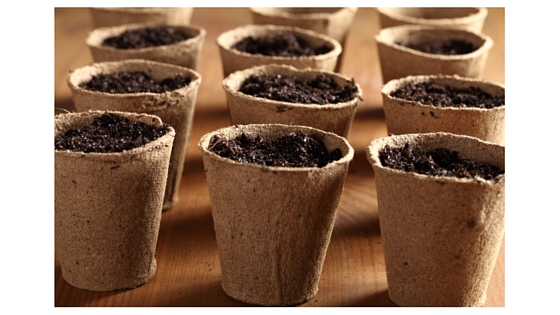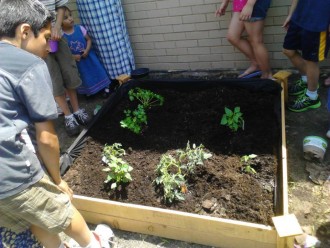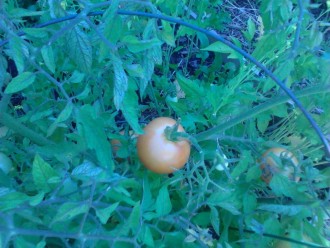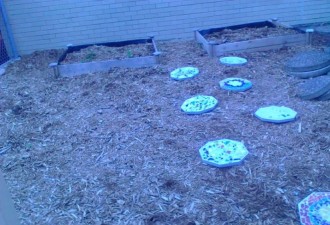The STEM Garden

The Stickney-Forest View Public Library district serves a diverse community of approximately 10,000[1] including two elementary school districts, a middle school and two high school districts. Approximately one third of our students have limited English proficiency and other learning challenges and approximately three quarters are economically disadvantaged.[2] Like all economically distressed communities, the current economic climate is a struggle for our patrons and resulted in many children experiencing the job loss of a parent and in some cases, both parents. Few students own personal computers or have internet access at home. In our community, kids and teens also experience a lack of opportunity and hope due in part to the absence of summer recreational activities, organized sports and creative outlets. And despite two parks we lack spaces offering children direct relationships with nature.
The Library plays an essential role in reaching out to these students year round and especially with our annual summer reading program. We strive to meet their needs in fun and creative ways to improve reading proficiency and ensure future successful scholastic achievement through programming, story times, STEAM builders, Art Club, Science Club and daily fun activities and books of interest. For many years, library staff had wanted to include the outdoors in our activities and undertake a project to develop the lovely but unused outdoor space adjacent to our youth department. We imagined a safe and peaceful area that would incorporate the natural world into the lives of our kids with dreams of planting a garden and holding story times outdoors in the sunshine but due to numerous circumstances including lack of opportunity and funds, our vision seemed permanently delayed.
This connection with nature is vital to our healthy development as human beings and grants kids a much needed reprieve from days spent online, doing homework and keeping up with intense scheduling demands. In fact, according to Last Child in the Woods: Saving Our Children from Nature-Deficit Disorder by Richard Louv, such a connection is vital to children’s health and development. And can be a solution to counter the rising numbers of children presenting with obesity, attention disorders, and depression.
Back 2 Books Grant
Through an email from The Illinois State Library, we learned of a grant program entitled Another Opportunity for Back 2 Books. Funded by Library Services and Technology Act Funds[3], these competitive opportunities are awarded by The Illinois State Library and seek to pair collection development and purchasing of new materials with programming and activities that will engage target audiences in utilizing the new materials.
Our application for a Back 2 Books Grant entitled, The STEM Garden, sought to provide students and families served by our library with a community garden project with the goal of uniting the practical skills of hands-on gardening with the STEM principles of science, technology, engineering and math. By involving our patrons in every step of the way, we hoped to create an interest in the concepts of slow food and home vegetable gardens that would encourage a lifetime of healthy eating habits as well as promote the concepts of problem solving, self-reliance and self-esteem by the completion of the project.
In February of 2014, our project was funded for a total of $3500 to include the purchasing of new print materials in STEM related subjects, two raised garden beds and needed supplies to create a vegetable garden, seeds and seedlings for said garden, and native perennials including butterfly bushes. We also booked two expert speakers; Tim Magner of Green Sugar Press who would present a garden themed story time and then even spend the day with us actually planting our seeds and seedlings. And at the completion of our project, popular chef Mike Niksic would demonstrate healthy snacks and recipes that required little or no adult supervision with the hopes that children would discover ideas for simple healthy after-school snacks.
The STEM Garden Kickoff Party
Our festivities began on May 31, with a special story time presented by Tim Magner of Green Sugar Press. The author of several gardening books for children, Tim has a profound love of nature and for sharing his knowledge with others. Our story time was a big success with the kids and even whole families joining us outside for an afternoon of planting. Thankfully the weather cooperated with us that day. We all worked together on a beautiful sunny day and planted many different types of seedlings in our “pizza garden” including tomatoes, bell peppers, jalapenos, arugula and other lettuces as well as basil, parsley, cilantro and chives.
We also planted native wildflower seeds and giant sunflowers whose seeds would feed the birds we hoped to attract. We anticipated monarch butterflies would visit our perennial butterfly bushes as well. Though when we planted them they were still quite small, they developed beautiful purple clusters of flowers that did appeal to several butterflies, though the bushes themselves will not reach their full grown size for several years. We were also pleased to see these bushes attract honey bees.
Summer Activities
We held many garden themed activities throughout the summer as well, including several story times and crafts. Art Club created and wooden sticks marking where different vegetables were planted and designed beautiful cement mosaic stepping stones for a new garden path. Science Club learned to plant seeds in peat pellets and the reasons why butterfly bushes were important. Staff utilized the new STEM print materials in colorful displays and programs and encouraged their circulation.
Children visiting the library often asked to help water the plants and check on them. We held story times in the garden and encouraged active participation every Saturday, with patrons offering to weed for a few minutes here and there during their library visits. And slowly we began to notice our garden growing and changing. Most exciting of all was our first almost red tomato!
Harvest
Several times a week we would venture outside with patrons to check on our vegetables. At the end of July we began to reap our harvest! Handfuls of plump red tomatoes, bright green parsley, aromatic basil and sweet banana peppers landed on our service desk free for the taking for lucky patrons who visited. (insert jpegs harvest 1, 2 ,3, 4)
At least once a week, we picked our fresh organic vegetables and herbs and distributed them to our library family. Some shared recipes with us, suggesting adding fresh dill to chicken soup and that other nuts besides pine nuts blended up into a delicious pesto with our fresh basil.
Kids were encouraged to try vegetables they had never before eaten as was the case with banana peppers. After being repeatedly assured that they were not spicy, several children in one of our families tried them and yes, even liked them!
Completion
At the end of August, Chef Mike Niksic presented a program entitled Healthy Snacks with Chef Niksic and introduced us to simple snacks. Among the recipes Chef prepared were homemade blackberry sauce pureed and served with apple and pear slices, carrot salad with lime and honey dressing and a special treat of chocolate covered almonds. Chef stressed that all things are healthy in moderation. He shared with us that two of the healthiest things we could do were to drink water every day and walk whenever we could.
With the approaching cold weather, our bounty suffered with shortening sunny days and some chilly nights dipping into the freezing range. Sadly we cleared out our vegetable beds and mulched over our garden space until next year. Though it appears to be dormant, we as gardeners know that even during the coldest winter months, earth worms are hard at work aerating the soil underground and our perennials are only waiting for the brief dark months to pass before they are awakened by the sun’s warmth and life will begin again.
Acknowledgements
The author wishes to gratefully thank The Illinois State Library, Heather Shlah, director of The Stickney Forest-View Public Library District, Danielle Taylor, Head of Youth Services, and the Board of Trustees and staff of The Stickney-Forest View Public Library District.
References
- “United States Census Bureau.” Stickney (village) QuickFacts from the US Census Bureau. Accessed November 5, 2014.
- According to the 2012 State of Illinois School Report Card, Lyons School District 103 did not achieve adequate yearly progress and had been identified for district improvement according to the ATP specifications of the No Child Left Behind Act. In the 2011 National Assessment of Educational Progress, (NAEP) over 60% of students in grade 4 were classified as being basic or below basic in proficient reading skills. According to the 2013 Illinois School Report Card, at J. Sterling Morton High School, 88% of students were classified as low income. The graduation rate was 70% and 18% of students were college ready.
- “Illinois State Library.” Another Opportunity for Back 2 Books. Accessed November 5, 2014.
Tags: library gardens, STEM programming















